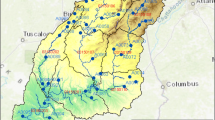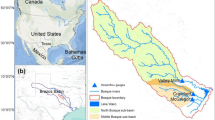Abstract
Detailed analyses of hydrological and water quality variables are very important to study the dynamic processes in a river basin. In this study, we have further modified the Enhanced Soil and Water Assessment Tool (ESWAT) model by incorporating hourly evapotranspiration and overland flow routing modules. Results from comparison of the performances by two ESWAT versions indicate that the modified version performed better than the original model. The modified ESWAT model has reasonably reproduced observed time series runoff and most commonly collected water quality data. In addition, input data availability at required spatial and temporal resolutions is the major bottleneck in implementing many detailed hydrological models. In this paper, we have also developed a robust methodology to successfully disaggregate daily rainfall data into hourly datasets. Furthermore, we have assessed the implications of such daily rainfall disaggregation schemes on subsequent simulation of hydrological and water quality variables at river basin level. The outcomes suggest that the multivariate rainfall disaggregation scheme better reproduced observed rainfall and runoff data.
Similar content being viewed by others
References
Abulohom MS, Shah SMS, Ghumman AR (2001) Development of a rainfall–runoff model, its calibration and validation. Water Resour Manag 15(3):149–163
Allen RG, Periera LS, Raes D, Smith M (1998) Crop evapotranspiration; guidelines for computing crop water requirements. FAO Irrig Drain Pap 56. Rome, Italy, p 300
Arnold JG, Williams JR, Srinivasan R, King KW (1996) SWAT manual. USDA agricultural service and Blackland Research Center, Temple, Texas
Brown LC, Barnwell TO (1987) The enhanced stream water quality models QUAL2E and QUAL2E-UNCAS: user manual. Report EPA/600/3-87/007, EPA, Athens, Georgia
Cao W, Bowden WB, Davie T, Fenemor A (2008) Modeling impacts of land cover change on critical water resources in the Motueka River Catchment, New Zealand. Water Resour Manag. doi:10.1007/s11269-008-9268-2
Debele B (2005) Better insight into water resources management through integrated upland watershed and downstream waterbody hydrodynamic and water quality models (SWAT & CE-QUAL-W2). Ph.D. dissertation, Cornell University, Ithaca, NY, p 175
Debele B, Srinivasan R, Parlange JY (2007) Accuracy evaluation of weather data generation and disaggregation methods at finer timescales. Adv Water Resour 30(5):1286–1300
Frederick RH, Myers VA, Auciello EP (1977) Five to sixty minute precipitation frequency for the Eastern and Central United States. U. S. Dep. Commerce, National Weather Service, National Oceanic and Atmospheric Administration Tech. Memo NWS HYDRO 35, Silver Spring, MD, p 36
Fronteau C, van Griensven A, Bauwens W (1999) Construction and calibration of an integrated urban drainage model. In: Proceedings of the 5th international conference on water pollution, Lemnos, Greece May 24–26
Henze M, Gujer W, Marais GVR, Matsuo T, Mino T, Wentzel C (1995) Activated sludge model No. 2 IAWPRC scientific and technical reports, 3, London, U.K.
Hershernhorn J, Woolhiser DA (1987) Disaggregation of daily rainfall. J Hydrol 95:299–322
Hershfield DM (1961) Rainfall frequency atlas of the United States for durations from 30 minutes to 24 hours and return periods from 1 to 100 years. U.S. Dep. Commerce, Weather Bureau Technical Paper No. 40. Washington, DC, p 115
Holvoet K, Gevaert V, Griensven A, Seuntjens P, Vanrolleghem PA (2007) Modeling the effectiveness of agricultural measures to reduce the amount of pesticides entering surface waters. Water Resour Manag 21(12):2027–2035
Ireson A, Makropoulos C, Maksimovic C (2006) Water resources modeling under data scarcity: coupling MIKE BASIN and ASM groundwater model. Water Resour Manag 20(4):567–590
Koutsoyiannis D (2001) Coupling stochastic models of different time scales. Water Resour Res 37(2):379–392
Koutsoyiannis D, Onof C (2001) Rainfall disaggregation using adjusting procedures on a Poisson cluster model. J Hydrol 246:109–122
Koutsoyiannis D, Onof C, Wheater HS (2001) Stochastic disaggregation of spatial–temporal rainfall with limited data. 26th General assembly of the European geophysical society, Geophysical research abstracts, vol. 3 Nice
Koutsoyiannis D, Onof C, Wheater HS (2003) Multivariate rainfall disaggregation at a fine time scale. Water Resour Res 39(7):1–18
Masliev I, Somlyody L, Koncsos L (1995) On reconciliation of traditional water quality models and activated sludge models. Working paper WP-95-18, IIASA, Laxenburg, Austria
Mishra A, Kar S, Singh VP (2007) Prioritizing structural management by quantifying the effect of land use and land cover on watershed runoff and sediment yield. Water Resour Manag 21(11):1899–1913
Nash JE (1958) The form of the instantaneous unit hydrograph, vol. III. IUGG Gen. Assem. Toronto, IAHS Publ. no. 45, pp 114–121
Nash JE, Sutcliffe JV (1970) River flow forecasting through conceptual models. I. A discussion of principles. J Hydrol 10(3):282–290
Neitsch SL, Arnold JG, Kiniry JR, Williams JR (2001) Soil and water assessment tool (SWAT) theoretical documentation. Blackland Research Center, Texas Agricultural Experiment Station, Temple, Texas, p 781
Rauch W, Bertrand-Krajewski JL, Krebs P, Mark O, Schilling W, Schütze M, Vanrolleghem PA (2002) Deterministic modeling of integrated urban drainage systems. Water Sci Technol 45(3):81–94
Reichert P, Borchardt D, Henze M, Koncsos L, Rauch W, Shanahan P, Slomyody L, Vanrolleghem P (2001) River water quality model (RWQM) No. 1: II. Biochemical process equations. Water Sci Technol 43(5):11–30
Robertson DM, Roerish ED (1999) Influence of various water quality sampling strategies on load estimates for small streams. Water Resour Res 35(12):3747–3759
Robinson RB, Wood MS, Smoot JL, Moore SE (2004) Parametric modeling of water quality and sampling strategy in a high-altitude Appalachian stream. J Hydrol 287:62–73
Runkel RL, Crawford CG, Cohn TA (2004) Load estimator (LOADEST): a FORTRAN program for estimating constituent loads in streams and rivers. Techniques and methods Book 4, Chapter A5, USGS, Reston, VA, p 75
Shanahan P, Henze M, Koncsos L, Rauch W, Reichert P, Slomyody L, Vanrolleghem P (1998) River water quality modeling: II. Problems of the art. Water Sci Technol 43(5):11–30
Shanahan P, Borchardt D, Henze M, Rauch W, Reichert P, Slomyody L, Vanrolleghem P (2001) River water quality model no. 1 (RWQM1): I. Modeling approach. Water Sci Technol 43(5):1–9
Sharpley AN, Williams JR (1990) EPIC—erosion productivity impact calculator. Model documentation, U.S. Department of Agriculture, Agricultural Research Service, Tech. Bull, p 1768
Sincock AM, Wheater HS, Whitehead PG (2003) Calibration and sensitivity analysis of a river water quality model under unsteady flow conditions. J Hydrol 277:214–229
Socolofsky S, Adams EE, Entekhabi D (2001) Disaggregation of daily rainfall for continuous watershed modeling. J Hydrol Eng 6(4):300–309, ASCE
Szilagyi J (2003) State–space discretization of the Kalinin–Milyukov_Nash–Cascade in a sample-data system framework for stream flow forecasting. J Hydrol Eng 8(6):339–347, ASCE
United States Environmental Protection Agency (2000) National water quality inventory report. US EPA, Washington, DC
United States Soil Conservation Service (1986) Technical release 55: urban hydrology for small watersheds. USDA, NRCS, Conservation Engineering Division
Vandenberghe V, Van Griensven A, Bauwens W (2001) Sensitivity analysis and calibration of the parameters of ESWAT: application to the River Dender. Water Sci Technol 43(7):295–300
Van Griensven A (2002) Developments towards integrated water quality modeling for river basins. Ph.D. dissertation, Vrije Universiteit Brussel, Belgium, p 280
Van Griensven A, Bauwens W (2001) Integral water quality modeling of catchments. Water Sci Technol 43(7):321–328
Van Griensven A, Bauwens W (2003) Multiobjective autocalibration for semidistributed water quality models. Water Resour Res 39(12):1348–1356
Van Griensven A, Francos A, Bauwens W (2001) Sensitivity analysis and calibration of an integral dynamic model for river water quality. Water Sci Technol 45(5):321–328
Waichler SR, Wigmosta MS (2003) Development of hourly meteorological values from daily data and significance to hydrological modeling at H. J. Andrews Experimental Forest. J Hydrometeorol 4(2):251–263
White KL, Chaubey I (2005) Sensitivity analysis, calibration and validations for a multisite and multivariable SWAT model. J Am Water Resour Assoc 41(5):1077–1089
Author information
Authors and Affiliations
Corresponding author
Rights and permissions
About this article
Cite this article
Debele, B., Srinivasan, R. & Parlange, JY. Hourly Analyses of Hydrological and Water Quality Simulations Using the ESWAT Model. Water Resour Manage 23, 303–324 (2009). https://doi.org/10.1007/s11269-008-9276-2
Received:
Accepted:
Published:
Issue Date:
DOI: https://doi.org/10.1007/s11269-008-9276-2




